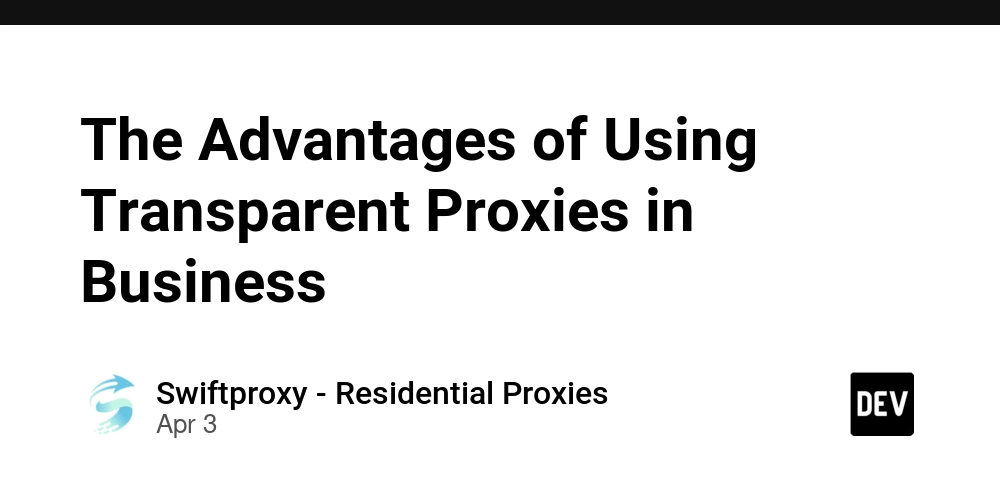The Advantages of Using Transparent Proxies in Business
You’ve probably used a transparent proxy without even realizing it. It’s likely lurking in the background of your daily web traffic, quietly making things faster, smoother, and more secure. If you’ve ever connected to public Wi-Fi or accessed a company network, there's a good chance you're already interacting with one. In this article, we’re going to break down what transparent proxies are, how they work, and why they’re crucial for businesses looking to boost performance and security. The Inner Workings of Transparent Proxy In simple terms, a transparent proxy acts as an intermediary between you and the website you’re visiting. Think of it as a traffic cop on the information highway—routing, filtering, and sometimes even blocking certain requests. The catch? It’s completely invisible to the user. Unlike non-transparent proxies that require manual setup and obscure your IP address, a transparent proxy leaves your data visible to the destination server. But it doesn’t require any action from you. For businesses, this is a huge win. Once configured on the network, a transparent proxy takes care of everything without needing individual user devices to adjust their settings. It’s seamless. Why Should Your Business Use a Transparent Proxy So, what can a transparent proxy actually do for your business? Let’s dive into its key use cases. These are real-world applications that can streamline operations, save bandwidth, and protect your data. User Identity Validation: Public Wi-Fi providers often use transparent proxies to ensure users agree to their Terms and Conditions before accessing the internet. This is an easy way to filter out unauthorized traffic and make sure only registered users are connecting to your network. Load Balancing: High-traffic websites rely on transparent proxies to distribute visitors across multiple servers. Instead of overwhelming one server, the proxy spreads the load, speeding up the website and enhancing user experience. Caching for Speed: Caching proxies store frequently accessed content like images and videos. The next time someone requests that same content, the proxy serves it from a nearby server, reducing load times and saving bandwidth. This is a game-changer for businesses that need to deliver content quickly and efficiently. Content Protection and Monitoring: Many companies use transparent proxies to monitor employees’ internet activity and block access to non-work-related sites. This not only ensures fair use of network resources but also keeps the workplace focused and productive. SSL Encryption: Transparent proxies can inspect HTTPS traffic and decrypt it for security purposes. This helps businesses ensure that sensitive data is protected from unauthorized access or tampering. DDoS Protection: Cyberattacks, like Distributed Denial of Service (DDoS), can bring down your website in an instant. Transparent proxies, specifically TCP intercept proxies, can handle such attacks by filtering out malicious requests, ensuring your site stays up and running. The Pros and Cons of Transparent Proxies Like any tool, transparent proxies come with their share of benefits—and challenges. Here’s what you need to know: The Benefits Better Performance: Thanks to caching, transparent proxies can drastically reduce loading times and improve the overall browsing experience. When traffic spikes, they keep your website running smoothly. Easy Setup: One of the biggest advantages is the ease of implementation. Transparent proxies are set up at the network level, meaning you don’t need to configure each user’s device. This is ideal for businesses managing a large number of users. Reliability Under Load: Transparent proxies handle large amounts of traffic well. They’re designed to step in when things start to slow down, keeping everything running smoothly even during peak usage times. The Drawbacks Risk of Network Slowdowns: If not configured properly, transparent proxies can cause network issues. Poor setup can lead to slow speeds, connection drops, and other performance problems. Privacy Concerns: Transparent proxies leave your IP address visible to websites, which could raise privacy concerns if sensitive data isn’t encrypted properly. Dependence on Network Equipment: Since these proxies are network-based, they’re dependent on the underlying network infrastructure. If something goes wrong at that level, the proxy may fail, causing disruptions. Ways to Detect a Transparent Proxy Want to know if you’re using a transparent proxy? It’s not always easy to spot, but there are a few tricks you can try. Examine HTTP Headers: By inspecting the HTTP response headers (using the Inspect option in your browser), you may see headers like "X-Forwarded-For" or "Via." These can indicate that your connection is passing through a proxy. Use Proxy Detection Tools: There are online tools that can help detect if you’re using a proxy. A quick search fo

You’ve probably used a transparent proxy without even realizing it. It’s likely lurking in the background of your daily web traffic, quietly making things faster, smoother, and more secure. If you’ve ever connected to public Wi-Fi or accessed a company network, there's a good chance you're already interacting with one.
In this article, we’re going to break down what transparent proxies are, how they work, and why they’re crucial for businesses looking to boost performance and security.
The Inner Workings of Transparent Proxy
In simple terms, a transparent proxy acts as an intermediary between you and the website you’re visiting. Think of it as a traffic cop on the information highway—routing, filtering, and sometimes even blocking certain requests. The catch? It’s completely invisible to the user. Unlike non-transparent proxies that require manual setup and obscure your IP address, a transparent proxy leaves your data visible to the destination server. But it doesn’t require any action from you.
For businesses, this is a huge win. Once configured on the network, a transparent proxy takes care of everything without needing individual user devices to adjust their settings. It’s seamless.
Why Should Your Business Use a Transparent Proxy
So, what can a transparent proxy actually do for your business? Let’s dive into its key use cases. These are real-world applications that can streamline operations, save bandwidth, and protect your data.
User Identity Validation: Public Wi-Fi providers often use transparent proxies to ensure users agree to their Terms and Conditions before accessing the internet. This is an easy way to filter out unauthorized traffic and make sure only registered users are connecting to your network.
Load Balancing: High-traffic websites rely on transparent proxies to distribute visitors across multiple servers. Instead of overwhelming one server, the proxy spreads the load, speeding up the website and enhancing user experience.
Caching for Speed: Caching proxies store frequently accessed content like images and videos. The next time someone requests that same content, the proxy serves it from a nearby server, reducing load times and saving bandwidth. This is a game-changer for businesses that need to deliver content quickly and efficiently.
Content Protection and Monitoring: Many companies use transparent proxies to monitor employees’ internet activity and block access to non-work-related sites. This not only ensures fair use of network resources but also keeps the workplace focused and productive.
SSL Encryption: Transparent proxies can inspect HTTPS traffic and decrypt it for security purposes. This helps businesses ensure that sensitive data is protected from unauthorized access or tampering.
DDoS Protection: Cyberattacks, like Distributed Denial of Service (DDoS), can bring down your website in an instant. Transparent proxies, specifically TCP intercept proxies, can handle such attacks by filtering out malicious requests, ensuring your site stays up and running.
The Pros and Cons of Transparent Proxies
Like any tool, transparent proxies come with their share of benefits—and challenges. Here’s what you need to know:
The Benefits
Better Performance: Thanks to caching, transparent proxies can drastically reduce loading times and improve the overall browsing experience. When traffic spikes, they keep your website running smoothly.
Easy Setup: One of the biggest advantages is the ease of implementation. Transparent proxies are set up at the network level, meaning you don’t need to configure each user’s device. This is ideal for businesses managing a large number of users.
Reliability Under Load: Transparent proxies handle large amounts of traffic well. They’re designed to step in when things start to slow down, keeping everything running smoothly even during peak usage times.
The Drawbacks
Risk of Network Slowdowns: If not configured properly, transparent proxies can cause network issues. Poor setup can lead to slow speeds, connection drops, and other performance problems.
Privacy Concerns: Transparent proxies leave your IP address visible to websites, which could raise privacy concerns if sensitive data isn’t encrypted properly.
Dependence on Network Equipment: Since these proxies are network-based, they’re dependent on the underlying network infrastructure. If something goes wrong at that level, the proxy may fail, causing disruptions.
Ways to Detect a Transparent Proxy
Want to know if you’re using a transparent proxy? It’s not always easy to spot, but there are a few tricks you can try.
Examine HTTP Headers: By inspecting the HTTP response headers (using the Inspect option in your browser), you may see headers like "X-Forwarded-For" or "Via." These can indicate that your connection is passing through a proxy.
Use Proxy Detection Tools: There are online tools that can help detect if you’re using a proxy. A quick search for "proxy detection" will give you plenty of options to check if your traffic is being intercepted.
Keep in mind, though—these methods aren’t foolproof. Even if you don’t find any evidence of a proxy, you could still be using one.
Wrapping Up
Transparent proxies may be invisible, but their impact is undeniable. They speed up your website, enhance security, and simplify network management. Whether you’re optimizing your corporate network or protecting your website from DDoS attacks, transparent proxies are a powerful tool.










































































































































































![[The AI Show Episode 142]: ChatGPT’s New Image Generator, Studio Ghibli Craze and Backlash, Gemini 2.5, OpenAI Academy, 4o Updates, Vibe Marketing & xAI Acquires X](https://www.marketingaiinstitute.com/hubfs/ep%20142%20cover.png)



























































































































![[DEALS] The Premium Learn to Code Certification Bundle (97% off) & Other Deals Up To 98% Off – Offers End Soon!](https://www.javacodegeeks.com/wp-content/uploads/2012/12/jcg-logo.jpg)


![From drop-out to software architect with Jason Lengstorf [Podcast #167]](https://cdn.hashnode.com/res/hashnode/image/upload/v1743796461357/f3d19cd7-e6f5-4d7c-8bfc-eb974bc8da68.png?#)






































































































.png?#)





.jpg?#)































_Christophe_Coat_Alamy.jpg?#)
 (1).webp?#)






































































































![Rapidus in Talks With Apple as It Accelerates Toward 2nm Chip Production [Report]](https://www.iclarified.com/images/news/96937/96937/96937-640.jpg)







































































































































